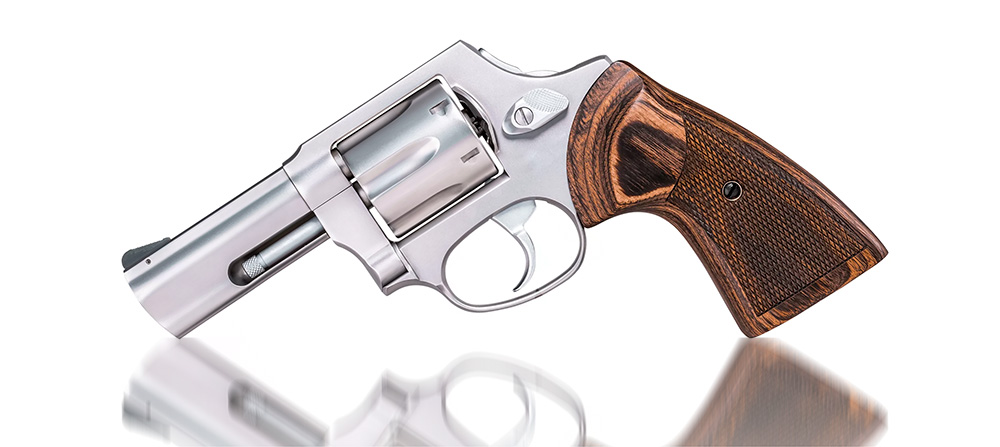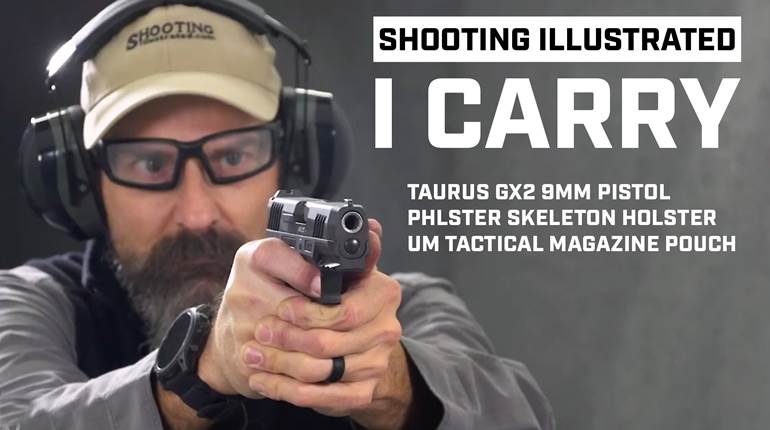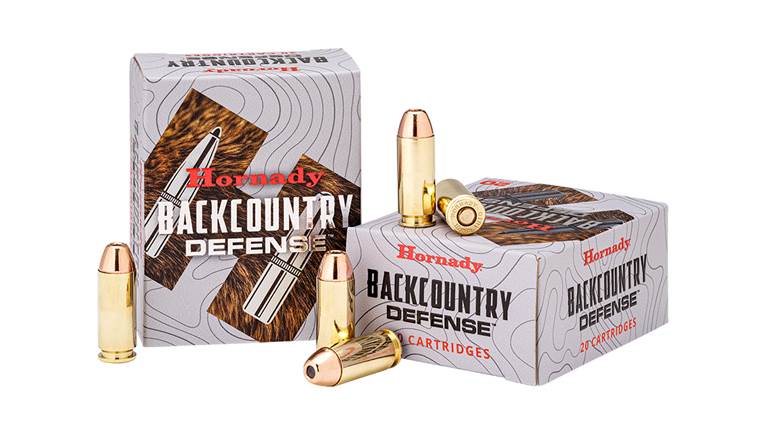
Most people have an insatiable desire for improvement. We want better homes, jobs and possessions—clothing, automobiles, cell phones, firearms—to name a few. We want something more, something “premium.” As American novelist Alfred Bertram Guthrie, Jr., said, “Good enough is never good enough.”
Subscribing to this adage, Bainbridge, Ga.-based Taurus Holdings, Inc., which is owned by the Brazilian firm Taurus Armas, S.A., introduced its Executive Grade line at the NRA Annual Meetings & Exhibits in 2022. Before examining it, though, an overview of the company, its past and its current offerings is in order.
A Solid foundation
When compared to many large-scale armsmakers, Taurus Holdings is young—the company was founded, after all, in 1982. Taurus Armas, on the other hand, produced its first handgun in 1941. Despite its relative youth, the business has amassed a great following—including decorated, professional competitive shooters Jessie Harrison and KC Eusebio—in the United States in short order. Why? Value, variety, performance and innovation, for starters. Whatever the mission—be it competition, hunting, home-defense, EDC or target shooting/plinking—Taurus has one or more revolvers or semi-automatic pistols that’ll meet your needs. What’s more, they’re affordable; protecting yourself, your family or your abode, or simply pursuing one of the many shooting sports, shouldn’t be cost-prohibitive. Even those with modest budgets have options with Taurus.
Additionally, the company has been at the forefront of innovation. For instance, the outrageously successful Judge, which debuted in 2006, is a revolver that employs .45 Colt/.410-bore shotshell interchangeability. Taurus’ ingenuity was on full display when that interchangeability concept was expanded with the Raging Judge 513, which fires the two aforementioned rounds in addition to the .454 Casull. Concerning Dick Casull’s 65,000-p.s.i. powerhouse, with the Raging Bull—eventually replaced by the Raging Hunter (in .460 S&W Mag.)—Taurus was among the first companies to offer affordable revolvers chambered for it. And this is only the beginning of its unique offerings; through the years, the company has created revolvers that fired .22 Hornet, .218 Bee and .30 Carbine, to name just a few.

The same traits are found in Taurus’ semi-automatics as well. Between its full-, Commander- and Officer-size M1911s, there are two chamberings and 10 total configurations from which to choose. The 9 mm Luger Taurus 92 is still available for traditionalists, while dozens of centerfire options are found between the G2, G3, GX4 and TH lines. As of this writing, there are 16 options within the TX22 rimfire series.
Taking the abovementioned accomplishments into account, you’d think that Taurus would consider resting on its laurels. Think again. While the company’s modern handguns are perfectly serviceable for their intended roles, there stands the opportunity for enhancements. Taurus recognized this and introduced the Executive Grade line.
According to Cody Osborn, then marketing director for the company, “It was a playground for Taurus to show what we can do. The goal of this premium line is to find better manufacturing methods and techniques that can trickle down to the standard line, improving the brand.” The first in the line was the 3"-barreled 856 Executive Grade, a double-action .38 Spl. +P revolver. For 2023, the single-action/double-action Judge was added. More on it shortly.
As for the line’s intended consumers, Osborn shared, “The Executive Grade line is marketed to the next generation of shooting enthusiasts, showing off that you can get a firearm with the features, fit and finish that are expected from a premium line, at a much better price.”
So, what do you get?
A Step Above
Depending on the company, “Custom Shop,” “Performance Center” and analogous monikers usually denote products that receive extra attention—be it to the mechanicals, furniture or finish (or all of the above)—by dedicated staff in a separate location. Taurus Executive Grade handguns are no different. “The dedicated manufacturing area is run by people who have the passion and desire to make the best firearms they can make,” Osborn said. “This was based off both skill and tenure.” Experience and dedication beget quality.
What differentiates Executive Grade handguns from their brethren? Taurus describes it as: “The Taurus Judge heightens its legacy—and your collection—with luxe styling, function-forward advancements and aesthetics galore.” In short, refinement. For example, the action is hand-tuned for improved single- and double-action trigger characteristics, and a hand-polished satin finish is applied to the hand-fit gun. Moreover, instead of polymer or rubber, the stocks are made from “presentation-grade” wood, and there’s a target hammer and brass front sight. Alone, these are little changes, however, taken together, performance and aesthetics are greatly improved.
Once completed, the Judge (or Model 856) Executive Grade is shipped in a lockable, black, Pelican Vault hard case with the foam pre-cut for a perfect fit and, thus, maximum protection. Accompanying the handgun is a black envelope containing a card with a message from Bret Vorhees, president and CEO of Taurus USA, an Executive Grade sticker, safety lock and the owner’s manual.
For fans of the Judge, the most recent beneficiary of the Executive Grade treatment and the subject of the review that follows, its pedigree as a premium Taurus product is immediately evident upon opening its case. Instantly noticeable is the absence of the functional, yet bland, black stocks. Instead, the revolver comes with wooden stocks, although, in my opinion, by no means are they “presentation-grade.” The grip swells considerably near the heel, nicely filling the hand for a solid hold. While the checkering is consistent, it’s also a tad smooth, so some purchase is sacrificed. Wherever the stocks join, they do so almost seamlessly; however, there was a noticeable gap between the top of the stocks and the rear of the frame, and one side was proud, too. Accenting the hardwood stocks is a satin finish on the stainless-steel frame, cylinder, yoke and other parts. The consistency of the finish was superb, with zero tooling marks noticeable.

On the left side of the frame is the spring-loaded cylinder release, which, between its shape and checkering, prevented slipping. Below it are the words, “Taurus Armas, Made in Brazil.” Pressing forward on the release frees the yoke to swing out for loading/unloading the fluted, five-shot cylinder. An extended extractor rod aids removal of .410-bore shotshells, which tend to “stick” after firing. It’s worth noting that .45 Colt and 2½" .410 shells can be used interchangeably and together in the same cylinder. Rearward of the cylinder, on the right side of the frame, are the words, “Executive Grade Taurus” and logo, while below the cylinder is found, “Taurus Int’l Mfg, Bainbridge, GA.” Atop the frame is an inset notch measuring 0.157" wide, which works in unison with the dovetailed, drift-adjustable, 0.160"-wide, black front sight that features a brass bar. Different, yes, but quite effective.
Given the length of the extended extractor rod, it makes sense that a lengthier housing is needed to protect it. And, so it is, running about two-thirds of the barrel’s length, which measured 3.05" on my sample gun. The barrel has 1:12.14" RH-twist rifling featuring six grooves, so don’t expect tight patterns with traditional birdshot and buckshot beyond spitting distance.
The Judge Executive Grade is a single-action/double-action revolver. It’s here, with the trigger-pull characteristics, that the additional attention by Taurus’ talent enhances performance. On the sample gun, in the single-action mode (target hammer cocked), the trigger has no creep and averaged 6 lbs. for five consecutive pulls. In double-action, the pull jumped to 10 lbs., 4 ozs.; while heavier, the travel was smooth, but the trigger reset was exceptionally long.
Getting Results
To evaluate the sample Judge Executive Grade, I gathered three .45 Colt loads for accuracy testing, as well as two types of .410—including one meant for defensive use. The .45 Colt loads included: Hornady Critical Defense 185-grain FTX; Hornady LEVERevolution 225-grain FTX; and SIG Sauer Elite Performance V-Crown 230-grain JHP. As for the shotshells, they were Aguila High Velocity 2½", 1/2-oz. 00 buckshot (four pellets) and Winchester Supreme Elite PDX1 410, the 2½" shell of which contained 12 plated BBs and three plated “Defense Disc” projectiles.
In keeping with its likely uses, I opted to test the Judge Executive Grade at 7 yards—using a Browning sandbag rest for consistency. Velocities were measured concurrently at a distance of 10 feet using a Competition Electronics ProChrono LTD chronograph. First up were the .45 Colt loads.

Given the upgrades Taurus made to the Judge Executive Grade, I anticipated somewhere between “good” and “exceptional” accuracy; happily, most groups were closer to the latter. For five consecutive, five-shot groups, the most accurate load proved to be the final one tested. Whether it was the load itself or the practice gained from those tested before it (or perhaps both), SIG Sauer’s Elite Performance V-Crown 230-grain JHPs produced the smallest 25-shot average—at 0.81". The smallest five-shot group with it measured 0.58". Barely edging out that group—at 0.56"—was one produced using Hornady LEVERevolution 225-grain FTXs. The mean for all five groups with that load was 0.92". Although the Hornady Critical Defense 185-grain FTX ammunition produced the largest groups across the board, all were sufficiently sized for self-defense. Regardless of the load, all groups struck slightly low and left. Thanks to the sight configuration, attaining the abovementioned accuracy wasn’t especially difficult.
Concerning velocities, a reduction was expected due to the Judge’s abbreviated barrel. The Hornady Critical Defense ammunition was within 16 f.p.s. of the published velocity for 10 consecutive shots and the SIG Sauer Elite Performance V-Crown was about 50 f.p.s. slower than factory speed. Not too bad. However, with the Hornady LEVERevolution 225-grain FTX round, the difference was significant—more than 100 f.p.s. It was very consistent ammunition, though, so a short barrel length was likely the culprit.
Next, I switched to the Aguila High Velocity 00 buck, which contained a 1/2-oz. payload. Although the thought of having four .33-cal. pellets, as opposed to one .45-cal. bullet, may sound appealing, the downrange performance proved otherwise. Due to the rifling, the pellets were randomly and wildly distributed, even at 7 yards. In fact, the smallest pellet scattering still measured 4¼", while the largest came to 14¾", and a fair number exceeded the 10" mark. Unless you’re exceptionally close, there are no guarantees that you can hit your target with all four pellets—or anywhere near where you’re aiming. I’d use something different, such as the 2½" Winchester Supreme Elite PDX1 410. Unlike the traditional buckshot, the plated discs of the Winchester shell tended to cluster tightly. The smallest knot measured a scant 1 1⁄8" across, while the largest was 4 1/2"; most split the difference or were slightly smaller. The BBs, however, were thrown all over; on one target, a 14 1/2" gap separated the farthest two BBs.
With official testing completed, I used the remnant ammunition to conduct a variety of defensive drills using a double-action trigger pull. With a long, but smooth, pull exceeding 10 lbs., shooting for groups at distance is challenging—hence why I tested the sample gun’s accuracy using the single-action mode. But, when shooting quickly, as you would in a close-range confrontation with an assailant, keeping the rounds where they needed to go wasn’t problematic. The weight of the gun and modest velocities generated by the .45 Colt loads made range time pleasant.
All in all, I enjoyed my time with the sample Judge Executive Grade—more so than with the run-of-the-mill ones I’ve tested in the past. It was certainly plenty accurate, particularly with the Hornady LEVERevolution and SIG Sauer ammunition, and there were no reliability issues whatsoever. Aesthetically, it’s above and beyond its brethren. Outside of the few observations mentioned about the stocks earlier, there’s really nothing that stands to be improved.
As you’d expect, the extra cost associated with creating Taurus’ Executive Grade handguns is passed along to you, the consumer. Expect to pay about a third more than you would for one of the standard variants. But, if you, too, are looking for “something better,” you’ll find it in the Executive Grade.
 Taurus T.O.R.O. Revolvers
Taurus T.O.R.O. Revolvers
As mentioned above, Taurus is a company of firsts—it continually brings innovative products to market. Its Taurus Optics Ready Option (T.O.R.O.) revolvers are a prime example. Rather than forgo the use of an optic, or have to pay handsomely for a gunsmith to solve the riddle, Taurus made things easy. The topstraps of T.O.R.O. revolvers are drilled and tapped to accept an included baseplate, which uses the Shield footprint. Within a literal minute, you’ll have the baseplate mounted and ready to accept a compatible red-dot sight. Since co-witnessing won’t be occurring, the handgun’s front sight can be removed.
On the Defender 856 T.O.R.O. that I received for evaluation, I mounted a Holosun EPS Carry. Honestly, it takes more time to scratch a lottery ticket than to attach the optic; however, Taurus recommends adding a drop of Loctite 243 to each screw and letting it cure for 24 hours before use. Sorry, no immediate range session. But, once set up, it’s unlikely to come loose.
Sure, batteries can die and optics can fail, but, given the choice, I’d opt for a T.O.R.O. model. Even if you don’t want to use an optic at the time of purchase, it provides the option down the road. Unsurprisingly, with the Holosun aboard my accuracy increased, but my time on target slowed initially. That was a temporary setback; with practice, I learned to acquire the dot and engage the target instantaneously. Perhaps the best illustration of the advantage of an optic atop the Taurus came when simulating target acquisition in very low light. Whereas the “irons” were not visible, the Holosun provided a perfect aiming point. And that is why you want a T.O.R.O. model.
Currently, there are four T.O.R.O. revolvers. The 3"-barreled Defender 856 (.38 Spl. +P) is available in matte black or stainless steel, and the 3"-barreled Model 605 (.357 Mag.) can be had in the same finishes. Consider the slight increase in cost a prudent investment.






































